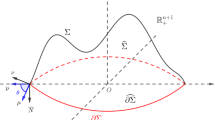Abstract
A new theoretical formulation is presented for the shape optimization problem associated with maximizing or minimizing the diffusive scalar transport from a two-dimensional body. In particular, we consider the diffusive transport of heat from an isothermal body into a medium with constant temperature at the far-field. The formulation also applies to mass and momentum transport. The diffusion problem, which is governed by the Laplace equation, is addressed using conformal mapping techniques where the two-dimensional domain is mapped onto a simpler domain where an analytical solution can be readily obtained. The objective function of the optimization problem is the length of the object in the transformed domain and the variables of the optimization are the parameters of the Schwarz-Christoffel transformation. The length of the object in the transformed domain is related to the scalar displacement, which corresponds to a far-field temperature drop or rise (slip velocity in case of momentum transport), that depends on the shape of the body and it quantifies the enhancement or reduction in transport rate. The mathematical formulation is validated by addressing two fundamental shape optimization problems associated with maximizing or minimizing the transport rate (drag in case of momentum transport) from a two-dimensional body of unit span: i) for a given surface area to obtain the shape that maximizes the transport rate from a body, ii) for a given volume to obtain the shape that minimizes the transport rate from a body. For both cases we compute numerically that the cylinder is the optimal shape. The versatility of the formulation is further demonstrated by including constraints with respect to the length of the body.
Similar content being viewed by others
References
Bechert DW, Bartenwerfer M (1989) The viscous flow on surfaces with longitudinal ribs. J Fluid Mech 206:105
Bejan A (2000) Shape and structure, from engineering to nature. Cambridge University Press, Cambridge
Biserni C, Rocha LAO, Bejan A (2004) Inverted fins: geometric optimization of the intrusion into a conducting wall. Int J Heat Mass Transfer 47:2577
Carslaw HS, Jaeger JC (1959) Conduction of heat in solids. Clarendon, Oxford
Choi KS, Prasad KK, Truong TV (1996) Emerging techniques in drag reduction. Mechanical Eng Publ, London
Currie IG (1974) Fundamental mechanics of fluids. McGraw-Hill, New York
Davis RT (1979) Numerical methods for coordinate generation based on Schwarz-Christoffel transformation. AIAA Paper No 79-1463, 4th computational fluid dynamics conference 180
Driscoll TA (2001) Schwarz-Christoffel toolbox user’s guide
Driscoll TA, Trefethen LN (2002) Schwarz-Christoffel mapping. Cambridge University Press, Cambridge
Fletcher R (1987) Practical methods of optimization. Wiley, New York
Fletcher R, Powell MJD (1963) A rapidly convergent descent method for minimization. Comput J 6:163
Fyrillas MM (2008) Heat conduction in a solid slab embedded with a pipe of general cross-section: shape factor and shape optimization. Int J Eng Sci 46:907
Fyrillas MM, Pozrikidis C (2001) Conductive heat transport across rough surfaces and interfaces between two conforming media. Int J Heat Mass Transfer 44:1789
Goldfarb D (1970) A family of variable metric updates derived by variational means. Math Comput 24:23
Kacimov A (2001) Optimal shape of variable condenser. Proc R Soc Lond A 457:485
Kacimov AR (2006) Analytical solution and shape optimization for groundwater flow through a leaky porous trough subjacent to an aquifer. Proc R Soc Lond A 462:1409
Lauga E, Stone HA (2003) Effective slip in pressure-driven Stokes flow. J Fluid Mech 489:55
Lecoq N, Anthore R, Cichoki B, Szymczak P, Feuillebois F (2004) Drag force on a sphere moving towards a corrugated wall. J Fluid Mech 513:247
Luchini P, Manzo F, Pozzi A (2004) Resistance of a grooved surface to parallel flow and cross-flow. J Fluid Mech 513:247
Milne-Thomson LM (1986) Theoretical hydrodynamics. Dover, New York
Morse PM, Feshbach H (1953) Methods of theoretical physics, Part II. McGraw-Hill, New York
Optimization toolbox (2000) The MathWorks Inc
Osserman R (1986) A survey of minimal surfaces. Dover, New York
Owen D, Bhatt BS (1992) On flow through porous material using a generalized Schwarz-Christoffel theory. Phys Fluids 71:3174
Panton RL (1984) Incompressible flow. Wiley, New York
Pironneau O (1984) Optimal shape design for elliptic systems. Springer, New York
Richardson S (1971) A model for the boundary condition of a porous material: Part 2. J Fluid Mech 49:327
Swamee PK, Mishra GC, Chahar BR (2001) Design of minimum seepage loss canal sections with drainage layer at Shallow depth. J Irrig Drain Eng ASCE 127:287
Author information
Authors and Affiliations
Corresponding author
Rights and permissions
About this article
Cite this article
Fyrillas, M.M. Shape optimization for 2D diffusive scalar transport. Optim Eng 10, 477–489 (2009). https://doi.org/10.1007/s11081-008-9071-1
Received:
Accepted:
Published:
Issue Date:
DOI: https://doi.org/10.1007/s11081-008-9071-1




